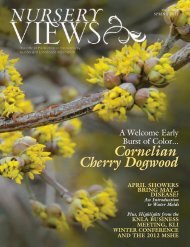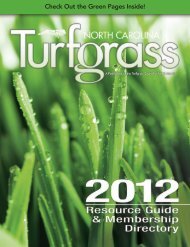Trees, Shrubs & Tropical Plants
Trees, Shrubs & Tropical Plants
Trees, Shrubs & Tropical Plants
- No tags were found...
Create successful ePaper yourself
Turn your PDF publications into a flip-book with our unique Google optimized e-Paper software.
VOL. 12/NO. 2Summer 2011Best & Beautiful<strong>Trees</strong>, <strong>Shrubs</strong> &<strong>Tropical</strong> <strong>Plants</strong>from the UT GardensRetail Solutions:Helping CustomersDiversify Their LandscapeHICCUP Your Way PastCompetitors on Facebook
TennesseeGREENTIMESThe Official Publication of The Tennessee Nursery and Landscape AssociationTable of ContentsVOL. 12/NO. 2Summer 2011In the Landscape8 12 16from the UT GardensBest & Beautiful <strong>Trees</strong>,<strong>Shrubs</strong> & <strong>Tropical</strong> <strong>Plants</strong>Garden Center IdeasRetail Solutions: HelpingCustomers DiversifyTheir LandscapeRECENT EVENTTN Green IndustryField Day… June 14at the UT GardensOTHER FEATURESNEWS FROM THE UT GARDENSWhat’s Going On So Far This Year at the UT Gardens .................................... 18MARKETING STRATEGIESHICCUP Your Way Past Competitors on Facebook .......................................... 20departmentsFrom the President, John Watson, CLP .................................................................. 6News from TNLA.......................................................................................................... 7TNLA New Members .................................................................................................. 7Calendar of Events...................................................................................................... 22Index of Advertisers .................................................................................................. 22The Tennessee Nursery and LandscapeAssociation serves its members in the industrythrough education, promotion and representation.The statements and opinions expressedherein are those of the individual authors anddo not necessarily represent the views of theassociation, its staff, or its board of directors,Tennessee Green Times, or its editors.Likewise, the appearance of advertisers, ortheir identification as Tennessee Nursery andLandscape Association members, does notconstitute an endorsement of the products orservices featured in this, past or subsequentissues of this quarterly publication.Copyright ©2011 by the Tennessee Nurseryand Landscape Association. Tennessee GreenTimes is published quarterly. Subscriptions arecomplimentary to members of the TennesseeNursery and Landscape Association.POSTMASTER: Send change of addressnotification to Tennessee Nursery andLandscape Association, 115 Lyon Street,McMinnville, TN 37110. Postage guaranteed.Third-class postage is paid at Nashville, TN.Printed in the U.S.A.Reprints and Submissions: Tennessee GreenTimes allows reprinting of material. Permissionrequests should be directed to the TennesseeNursery and Landscape Association. We arenot responsible for unsolicited freelancemanuscripts and photographs. Contact themanaging editor for contribution information.Advertising: For display and classifiedadvertising rates and insertions, please contactLeading Edge Communications, LLC, 206Bridge Street, Franklin, TN 37064, (615) 790-3718, Fax (615) 794-4524.
from the presidentJohn Watson, CLPA Letter from theTNLA BoardTNLAWould like toTHANKthe followingcompanies for beingMEMBERSHIPSPONSORSGold Membership SponsorsBarky Beaver Bark & SoilMix, Inc.Common Grounds LandscapeManagement, Inc.Oldcastle Adams Products /BelgardRandall Walker FarmsSwafford Nursery, Inc.Silver Membership SponsorsAllen Landscape ManagementDutchman Tree SpadeFreedom Tree Farms, LLCNashville LandscapeSystems, Inc.Packs NurseryThe letter below is being sent to prospective members. At our recent meetingof the TNLA board of directors, we decided to re-focus on the growth of ourassociation as a way to bring the state’s green industry together. This letter willbe sent to anyone you would recommend for membership. Simply email, fax orphone the contact information to the TNLA office (931-473-3951), and the staffwill take it from there.Dear Partner in the Green Industry,Why should you join the Tennessee Nursery & Landscape Association? Withyour membership, you will become part of a dynamic, growing organization thatworks for you. For over 100 years, the TNLA has showcased the product qualityand extensive knowledge that Tennessee nursery growers and landscapers offer.For pennies a day, you can get all the benefits of TNLA. Last year, for the $200investment, TNLA spent over $600 on each member’s behalf. This makes membershipin TNLA one of the best returns on investment you can make. By joining today,your TNLA membership:• Markets your business. The TNLA organization works avidly at marketingyour business through physical representation at national trade shows, as wellas through the internet. Every individual business of TNLA members is listedon the TNLA website, with the option of links to their own business website.Each member is listed in our annual membership directory, which is distributedthroughout the United States. Your membership also offers you discountedlistings and advertising in the widely distributed TNLA Buyers Guide.• Lobbies for your business. The TNLA organization, along with the TNLAlobbyist, reviews current legislative bills and issues that affect your business. TheTNLA is your voice on bills concerning immigration, land rights, sales tax, waterlaws and all issues that play an integral role in your day-to-day operations. TheTNLA assures that you are heard in Nashville and Washington.• Expands your network. Currently, more than 400 companies benefit by beingconnected to a network of peers, industry researchers and customers. Yourmembership includes discounts at the TNLA co-sponsored Mid-States HorticulturalExpo in Louisville, Kentucky, a venue that brings wholesale growers,retailers, equipment suppliers, landscapers and educators to a national customerbase. Membership also means discounts for TNLA’s Winter Education seminarsin Pigeon Forge, Tennessee, and the Tennessee Green Industry Field Day.Enclosed is a return membership application. Should you have any questions,please call our offices at (931) 473-3951. We look forward to you joining the TNLA.Sincerely,The TNLA Board6tennessee greentimes SUMMER 2011
News from TNLAThe Tennessee Greentimes is the officialpublication of The Tennessee Nursery& Landscape Association, Inc.115 Lyon StreetMcMinnville, Tennessee 37110(931) 473-3951Fax (931) 473-5883www.tnla.comEmail: mail@tnla.comTNLA on the Hill!Published byLeading Edge Communications, LLC206 Bridge StreetFranklin, Tennessee 37064(615) 790-3718Fax (615) 794-4524Email: info@leadingedgecommunications.comEditorsDr. Bill KlingemanDr. Amy FulcherAssociate EditorsDr. Donna FareDr. Nick GawelMr. Mark HalcombDr. Frank HaleMr. Gray HaunDr. Sandy ReedDr. John SorochanTNLA OfficersPresidentJohn Watson, CLPCommon Grounds Landscape Mgmt.1st Vice PresidentMichael KasseesForest Nursery Co., Inc.2nd Vice PresidentBill SeatonTruGreen LandCare3rd Vice PresidentMatt DawsonNatural Creations, LLCTennessee lawmakers celebrated Ag Day at the state capitol on April13. TNLA staff, as well as several TNLA board members, were thereto represent the nursery and landscape industry. Above (left to right),Pam Stern (TNLA administrative assistant), David Keith (actor) andLouree Walker (TNLA executive director).Welcome, TNLA New Members!ACTIVE MEMBERSBeaver Creek LandscapeManagement, LLCJohn Bottis2247 Cartmill DriveKnoxville, TN 37849My Personal GardenerMark Sharp1753 Knob RoadMaryville, TN 37803ASSOCIATE MEMBERSDeal’s Distributing Co., Inc.Barbara Deal476 N. Main StreetClinton, TN 37716Evergreen NurseryGeri Renn23556 Wallace Road NWSalem, OR 97304Secretary-TreasurerRandall WalkerRandall Walker FarmsAssociate DirectorMary (Strong) PenningtonLandscape Support ServicesEx-OfficioTim GallagherHeather Farms Nursery, Inc.Executive DirectorLouree WalkerAdministrative AssistantPam Sterntennessee greentimes SUMMER 2011 7
In the LandscapeUT Gardens’2010 Best& Beautiful<strong>Trees</strong>, <strong>Shrubs</strong> and<strong>Tropical</strong> <strong>Plants</strong>Prepared by Susan Hamilton, Ed.D., Director ofthe UT Gardens; James Newburn, Assistant Directorof the UT Gardens; Jason Reeves, Curator of theJackson UT Gardens; Beth Willis, Trials Coordinator;and Betty Tipton, Plant Evaluation CoordinatorNote: Check local nursery availability of listed varieties atthe UT Gardens website – http://utgardens.tennessee.edu.TREES AND SHRUBSAcer palmatum var. dissectum ‘Red Select’ — RedSelect cutleaf Japanese maple. One of the best maplesknown for retaining red foliage all season. Its red lacyfoliage turns a brilliant crimson fall color. It has a slightlyweeping form and will ultimately top out at about 12 to15 feet tall, with a generous spread up to 10 feet wide.Callicarpa americana ‘Welch’s Pink’ — Welch’sPink American beautyberry. This new introductionis named for its pink midsummer flowers and pinkautumn berries. It grows 3 to 6 feet tall and thrivesin full sun and partial shade.Camellia sinensis — tea camellia or tea bush. Thisdense, evergreen shrub grows to between 4 feet and 6feet tall and just as wide. It produces leathery, darkgreenleaves and covers itself each fall with fragrantwhite flowers. ‘Rosea’ is one with pink flowers.‘Shirotae’ is a selection with pewter-colored leaveswith white margins, and ‘Silver Dust’ has new growththat emerges almost white. ‘Gold Splash’ has largegreen and yellow variegated leaves.Cotinus coggygria ‘Grace’ — purple smoketree orsmokebush. This hybrid is a lovely deep mauve thatflashes reddish leaf undersides. It has large mistyblooms, the feature that gives the plant its commonname. It can be left to grow as a small tree up to 15feet tall or managed as a shrub if it is pruned backseverely each year.8tennessee greentimes SUMMER 2011
In the LandscapeGardenia jasminoides ‘Kleim’sHardy’ — daisy gardenia. ‘Kleim’sHardy’ gardenia produces massesof fragrant, single, daisy-shapedwhite flowers in late spring/earlysummer. Growing up to 3 feet, it hasa mounding habit with very darkgreen, lustrous foliage and heavierblooms than other gardenias.Ginkgo biloba ‘Mariken’ —Mariken maiden tree. A wonderfuldwarf cultivar, this slow-growingselection is ideal as a container orspecimen plant. It grows only 2 to 3feet tall and can develop a pendulous,weeping shape when mature. It hasbrilliant golden foliage in fall.Juniperus chinensis ‘Holbert’ —Holbert Chinese juniper. With aspreading growth habit of 8 to 9feet wide and just 2 to 3 feet high,this juniper features blue foliagethat holds color through thewinter months.Nyssa sylvatica‘Zydeco Twist’ —Zydeco Twist blackgum. This contortedbranchedblack tupelo(or sourgum) has anespecially striking form after thevivid red fall foliage drops. Tolerantof a wet site, it grows to 20 feet tall.Thuja occidentalis‘Sunkist’ — Sunkistoriental arborvitae. Oneof the brightest yellowgoldconifers available,this variety is tolerant ofpartial shade to full sun and a moist todry and well-drained site. It grows upto 4 feet tall and 2 to 3 feet wide.Thuja orientalis‘Franky Boy’ —Franky Boy orientalarborvitae. Finely texturedfoliage and abright chartreuse colorthat turns bronzy-orange in the wintermake this a winning year-round plant.Its growth habit creates a dwarfconifer with an overall plant formof a teardrop.Thuja orientalis ‘VanHoey Smith’ — VanHoey Smith orientalarborvitae. Thisarborvitae grows upto 6 feet tall, withbeautiful variegatedgreen and gold finely texturedfoliage.Viburnum setigerum — teaviburnum. A great native shrubwith showy spring blooms, good fallcolor and outstanding fall fruit. Manypeople mistake this for a winterberryholly because it is also deciduous.Growing 8 to 12 feet tall and 5 to 8feet wide, this is a wonderful shrubfor attracting birds.ROSESRosa ‘Carefree Marvel’ — CarefreeMarvel shrub rose. This bright, deeppinkrose is a low-growing rose with abroad habit, growing up to 2 feet talland 3 to 4 feet wide. Disease resistantand low maintenance, it is ideal forspilling over a rock wall or ledge.Rosa ‘Kimberlina’ — Kimberlinafloribunda rose. This 2009 Floribundaof the Year ® winner is outstanding.The soft-pink blooms would workwith any color combination, especiallywith its dark-green foliage. It is toutedas being one of the most vigorousfloribundas ever introduced.Rosa ‘Lynn Anderson’— Lynn Andersonhybrid tea rose.Abeautiful, vigoroushybrid tea rose witha mild fragrance. Itscreamy white centerblends to light thendark-pink edges.10tennessee greentimes SUMMER 2011
In the LandscapeRosa ‘Rainbow Sunblaze’ —Rainbow Sunblaze miniature rose.This rose has beautiful doubleflowers that stay well above thefoliage. The center of the bloomis yellow, with the outside petalsa contrasting orange-red.Rosa ‘Tournament of Roses’ —Tournament of Roses hybrid tearose. With a soft, delicate pinkcoloredrose that is very fragrant,this selection looks great from atight bud until fully open.originally sold for as much as $1,500!It very quickly grows to 8 feet tall,but it is not believed to be cold hardy.Musa velutina — pink velvetbanana. Beautiful pink flowers andfruit make this a striking banana.Rarely exceeding 6 feet tall, thisbanana produces copious flowerstalks near the top of the trunk,starting in late summer. Each stalkproduces clusters of small, pink,velvet bananas that peel themselveswhen ripe (although they’re notgood for eating!). CTROPICAL PLANTSAechmea ‘WallyBerg’ — Wally Bergbromeliad. With anew, unusual andstriking color, thisbeautiful red-orangeselection was developed by the lateWally Berg of Sarasota, Florida.Ananas comosum— pink variegatedpineapple. Everyoneloves the creamywhite, pink and greenvariegated foliageof this pineapple plant. It stands outas a striking specimen plant.Kalanchoe thyrsiflora‘Flapjack’ — Flapjackkalanchoe. Thisclumping succulenthas large, flat bluegreenleaves with redleaf margins and — you guessed it —is shaped like a flapjack. When grownin full sun, the leaf margins becomeeven redder and broader. This is trulya desert plant, which makes it anideal plant for a xeriscape or lowwaterusage area.Musa acuminata‘Siam Ruby’ — SiamRuby banana. A rare,red-leaved bananafrom the wilds of NewGuinea, this planttennessee greentimes SUMMER 2011 11
Garden center IdeasBy Andy Pulte, Faculty Instructor, Department of Plant Sciences,The University of TennesseeThere are many reasons plantsbecome overused in the landscape.Themain reason is simplybecause a plant displays several practicalor pleasing features. <strong>Plants</strong> that lackprized attributes aren’t successful in thenursery trade and, in turn, won’t reachyour customer’s front yard. For manyretail outlets, it’s a hard choice to notsell familiar plants that will most likelyfind an easy home. Start by choosinga few suitable replacements plants, andthen make it a point to educate staff andcustomers about their choices. Knowingthe benefits and downfalls of any type ofplant material makes good sense. Valueadded by time spent educating receptivecustomers can forge loyalty anda positive relationship.Undoubtedly, if you own or operatea garden center, someone this yearwill ask if you carry ‘Bradford’ pears.For garden centers that don’t, it makesgood sense to point customers in adifferent direction. Here are a few wellwornplants, and some suggestions tohelp jump-start the diversity of anycustomer’s landscape.Pyrus calleryana ‘Bradford’— Bradford pearIt’s not without good reason that plantslike Bradford pear get overused. Greatfoliage, spring flowers, breathtaking fallcolor and reliable form made Bradforda go-to plant for homeowners throughoutthe 1980s and early 1990s. If onlyconsumer behavior was as easily brokenas a 15-year-old Bradford in a windstorm.Currently, many of the Bradfordsplanted 20 years ago or less have failedin the landscape due to wind damage.Additionally, escaped pear seedlingsfrom these parents continue to spreadinto native woodlands. Growing awarenessof these concerns has led to a drasticcutback in commercial production.Plant substitutions that provide all ofthe four-season characteristics given by aBradford pear tree are admittedly hardto come up with. However, my numberone choice for replacing a Bradford isParrotia persica – Persian parrotia (Zone(4)5–8). Parrotia is a small, single ormulti-stemmed tree with lustrous leavesthat resemble the Bradford in theirshine. Additionally, it has great bark thatexfoliates as the tree gains age. Thistree doesn’t disappoint in fall, as leaveschange into a deeper green followed byan autumn show of purple, reds, orangesand yellows. Although slightly insignificantwhen compared to the bloom ofBradford, Parrotia trees have bloomsthat come out earlier and last longerthan any pear, nor do fruit produce anabundance of nuisance seedlings.Another suggestion: Nyssa sylvatica‘Red Rage ® ’ — black gum (Zone 4–9).Picea glauca ‘Conica’ —Dwarf Alberta spruceFiercely cold hardy, slow growing andeasy to propagate, dwarf Alberta sprucehas become a favorite foundation plantfor many gardeners and weekend landscapewarriors. Those with experiencecan argue that overuse, insect and mitedamage and die-back in Alberta sprucetrees are regular cause for concern.Platycladus orientalis ‘Morgan’ (Zones6-10) is perhaps one of the best substitutesyou can make for dwarf Albertaspruce. ‘Morgan’ arborvitae (Zones 2-6),which has a slightly rounder shape, iscomparable in form. Known as a woodychameleon, ‘Morgan’ has an exceptionalability to change foliage color. As winterapproaches, this conifer changes from anemerald/lime green color to a beautifuldeep purple. Well before spring, it settlesinto a breathtaking copper color. Then,as temperatures warm, Morgan returnsto its summer green.Another alternative is Chamaecyparisobtusa ‘Nana’ — dwarf hinoki cypress(Zone 4-8).x Cupressocyparis leylandii— Leyland cypressAlthough hard to find unaccompaniedby other Leylands, when you see one asa single specimen, with room on all sides,it truly is a beautiful plant. Leylandcypress is fast growing and easy to propagate,transplants readily and can handlea variety of environmental conditions.What could go wrong? Leyland is aplant that can grow three feet a yearif it’s happy (Zone 6–10) and makes asolid evergreen screen fast. However,it seems likely we are again destinedto learn the lesson of planting monocultureswith this plant. Problems such asseiridium canker paired with variousroot diseases may cause a privacy screento become not so private.The best way to ensure your customershave a long-lasting privacyscreen is to suggest mixing up the12tennessee greentimes SUMMER 2011
Above Left: ‘Limelight’hydrangea makes an excellent,smaller substitute forcrapemyrtle.Above Center: The foliageof Parrotia persica is a shinygreen, similar to Bradfordpear leaves.Above Right: Persianparrotia also featuresinteresting bark exfoliation.Left: ‘Morgan’ Arborvitae isbecoming more commerciallyavailable and makes a nicefocal point in landscapes.tennessee greentimes SUMMER 2011 13
Garden center IdeasTable 1. A few time-worn plants and possible reasons why you might suggestplant alternatives to customers, as well as some potential plant replacements.If customer isreplacing:AzaleasBoxwoods andJapanese holliesBradford pearCrapemyrtleDwarf AlbertaspruceFloweringdogwoodLeyland cypressNandina(Common)Silver andsugar maplePossible reasons why:Lack of drought tolerance, lackof adaptability, insect anddisease susceptibility, overusedRoot rot, poor site-specificperformance, inadequatedrainage, overusedStorm damage, overuseToo large for planned space,hardiness issues, overusedInsect damage, die-back,overusedDisease, insect damageSeiridium canker and rootdiseases, stem flagging anddie-back, overusedLeaf spot, root rot, mild toxicity,invasiveness, overusedShallow roots, size, rapidgrowth, diseases, die-back,weedy, competition with turfAlternatives to suggest:Fothergilla, Enkianthus,Corylopsis spp.,oakleaf hydrangeaAbelia, Cryptomeriajaponica ‘globosa nana’,dwarf yaupon hollyParrotia, black gum,Malus spp., hawthornDwarf crapemyrtle, Vitex,panicle hydrangeaPlatycladus orientalis‘Morgan’, Chamaecyparisobtuse ‘Nana’, ‘Black Dragon’Japanese CryptomeriaKousa dogwood,disease-resistant floweringdogwood cultivars‘Green Giant’ arborvitae,Arizona cypress, Japanesecryptomeria, Ilex spp.Spiraea thunbergii ‘Ogon’,Fargesia rufa ‘Green Panda’Zelkova, Katsura tree,yellowwood,Linden/basswoodplant material they use. Screens shouldhave several different types of plantslayered together with different colorsand textures. One of the plants that cankeep up the pace with Leyland is Thuja(standishii x plicata) ‘Green Giant’(Zone (4)5-7(8). Green Giant arborvitaedoes have a tendency to yellowslightly in the winter, but it grows nearlyas quickly as Leyland. Green Giantgrows to over 40' tall, with a dense,narrow, classically pyramidal habit.Another suggestion: Cupressusarizonica var. glabra ‘Blue Ice’ — orBlue Ice Arizona cypress (Zone (6)7–9)Lagerstroemia indica —CrapemyrtleCrapemyrtle is truly a beloved plantthat can be versatile in the landscape.However, many of the traditionalvarieties may be oversized for evenmodest-sized yards. Depending onyour location, lack of cold hardiness orhaving general overuse concerns maybe a good reason to diversify.If a client wants a crapemyrtle butdoesn’t have the room, suggest a cultivarlike ‘Pocomoke’ that stays relativelydwarf. A great substitute with manysimilar characteristics would beHydrangea paniculata or the paniclehydrangea (Zone 3–9). There are manysuperb cultivars of this plant, including‘Limelight ® ’, that produce beautifulpanicles of flowers late in the season.Another suggestion: Vitex agnuscastus— chastetree (Zone 6b–8).The companion table notes a fewplants that may provide opportunitiesfor landscape diversification andpossible reasons why you and youremployees might suggest plant alternatives,as well as some potential plantsthat could be aesthetically competitivereplacements. Before suggesting anynew types of plant material, you andyour employees should become familiarwith both the positive and negativeattributes of each plant and how youmight expect them to perform withinyour geographic location and localUSDA Plant Hardiness Zone. It maymake sense to gather knowledge aboutsome specific cultivars for each plant. C
Recent EventSnapshots from theTENNESSEE GREENINDUSTRY FIELD DAYJune 14, at the UT Gardens in Knoxville, TN16tennessee greentimes SUMMER 2011
Thanks to Our Field Day’sPrimary Sponsor!Tennessee Dept. of AgricultureA Very Special Thanks to…the University of Tennessee GardensStaff and nursery and landscaperesarchers and specialists:Dr. Amy FulcherDr. Sue HamiltonDr. Bill KlingemanJimmy MynesJames NewburnAndy PulteDr. Karen VailBeth WillisThanks to Our ExhibitorsAiritech ToolsBlankenship FarmsCherokee ManufacturingDeal’s Small EngineDickens Turf & Landscape SupplyFarm Credit ServicesGriffin Greenhouse &Nursery SuppliesHeather Farms NurseryHortica Insurance &Employee BenefitsJohn Deere LandscapesPleasant Cove Nursery, Inc.Randall Walker FarmsRiverbend Nurseries, LLCRiverdale NurserySamara FarmsTennessee Dept. of AgricultureWalker Nursery Companytennessee greentimes SUMMER 2011 17
By Sue Hamilton, Ed.D., Director of UTGardens and All-American Selections JudgeWewill be trialing Bloomsof Bressingham perennialselections in theGardens during 2011, so visitors will getto see first-hand how these perennialsperform in our region. Together, fatherAlan (1906–2005) and son AdrianBloom have been responsible forintroducing over 200 perennial plantcultivars. Among these are numerousgarden favorites, which include thefollowing popular selections:1920s – Dianthus ‘Oakington’1930s – Phlox ‘Oakington Blue Eyes’1950s – Achillea ‘Moonshine’,Heucherella ‘BridgetBloom’, HeucheraBressingham hybrids1960s – Crocosmia ‘Lucifer’,Geranium ‘Ballerina’,Kniphofia ‘BressinghamComet’1970s – Astilbe ‘Sprite’ (1994 PPAPerennial Plant of theYear), Phlox ‘Eva Cullum’1980s – Leucanthemum ‘Snowcap’,Bergenia ‘BressinghamRuby’, Phlox ‘FranzSchubert’, Achillea ‘Anthea’1990s – Lavandula ‘Blue Cushion’,Polemonium ‘Brise d’Anjou’2000s – Geranium ‘Rozanne’ (2008PPA Perennial Plant of theYear), Campanula ‘BlueWaterfall’Garden center and nursery retailersmay want to consider carrying thisbrand of plants with the exposure itwill be getting in both the Knoxvilleand Jackson Gardens. For informationon this brand and how to become aretailer, go to http://bloomsofbressinghamplants.com.In mid-May, we launched a new UTFarmers Market with an array of localfarmers and growers, including UTstudent farmers who are part of UT’sOrganic & Sustainable Production Programthat offers internships to studentsto learn about hands-on production,from planning to production to directmarketing. The market offers not onlygreat fresh and locally grown produceeach week but also an ever-changingassortment of music, crafts, educationalactivities, cooking demonstrationsand a dinner buffet prepared withfresh local produce by the UT CulinaryInstitute student chefs. The market willbe at the Gardens in Knoxville everyWednesday from 4 p.m. to 7 p.m.,running through October.We moved our annual Blooms DaysMarket Place and Festival from itstraditional date of the last weekendin June to Mother’s Day weekend,which was May 7–8. The June heat andhumidity for the past two years spurredus to move Blooms Days to a morepleasant (weather-wise) month. It alsoput Blooms Days at the beginning ofthe gardening season — a great time toadd plants to the garden and a greattime to peruse the incredible selectionof plants and other great botanicallyrelated items for sale from the 30+Blooms Days vendors. Another reasonfor the move was that our Beall FamilyRose Garden was in the peak of bloomalong with the rest of the Garden’scollection of iris, clematis, speciestulip, peony and some choice springephemerals. To really showcase thebeautiful rose garden, one of the foureducational tracts of Blooms Days wasdedicated to roses and was taught bysome of our region’s best rosarians. Ittruly was a great opportunity to meetand learn from some of the best roseexperts around.We followed Blooms Days with aone-day Hydrangea Symposium onJune 18, where 55 attendees heardmorning lectures by noted hydrangeaexperts, including Dr. Sandy Reedof the U.S. National Arboretum (whospoke on her hydrangea breedingprogram) and hydrangea growerElizabeth Dean (from Wilkerson MillGardens). Lectures were followed byan exclusively hydrangea plant sale. C18tennessee greentimes SUMMER 2011
Marketing strategiesEvery company is trying to useFacebook in an attempt tomove their business forwardand stay connected to their customersin this fast-paced world. Why are somecompanies more successful at this thanothers? Content is the key to staying intouch with your customers and keepingthem informed. The content, however,must be a rich mix of information,education, humor and fun. Use theHICCUP approach, described below,to make your Facebook page moresuccessful.HUMORHumor allows your audience to comeaway with a warm, fuzzy feeling and afriendly attachment to your message.It doesn’t have to be industry specific,although it can be. You can do viralsearches on YouTube and/or sites thatplug social media. Always watch avideo all the way through before posting,as you don’t want it to include anyprofanity or other unmentionables.Remember video is king. Written blogsare being trumped by the clever, colorfuland often fun video blogs.INTERACTIVE QUESTIONSDon’t be afraid to ask open-endedquestions to your group. For example,if you are a landscape contractor, youmay want to ask, “What is the biggestproblem you have in your plantingbeds?” The purpose here is to beginthe conversation. People posting theiranswers will create a community buzz.Letting the responses unfold naturallyalso gives you a marketing advantage.You can then track the concerns andcreate future training or webinarsaround your customers’ needs.CONTENTIf you don’t provide a myriad of interestingtopics, information and currenttrends, current customers (as well asfuture customers) simply go away.Clicking “Unlike” on Facebook is justas easy as clicking “Like.” Smart, cleverand challenging content will keep youraudience waiting for more. With mostcompanies having a presence onFacebook, competition will becomefierce, and you have to stand out.CURRENT EVENTSIf you haven’t done so already, getplugged in to all online media and/ortrade publications online. When somethinginteresting pops up, pass it alongfor other people’s knowledge. If somethingpolitical occurs that impacts yourindustry for example, pass it along.Never make a personal judgment aboutthe event. Let your community unfold.Use Google Alerts in which you canprogram in key words to notify youof events and news feeds that pertainto your industry. Use a program likeHootsuite to consolidate, and Tweetevents out to all of your feeds andaccounts at one time.UTILIZE INDUSTRY FACTSKeep your followers abreast of changesin your particular industry, and relatethem back to your own business. Forexample, if you are a nursery growerand there are some new shipping regulationsaround the corner, keep peopleaware by posting them on Facebook.By Genae GirardIf you own a garden center, you maywant to post information on when anew shrub or tree variety is releasedand when it will be available at yourstore. These are specific actions thatendear your customers to your brand.PROMOS AND SPECIALSMention specials, promotions, new productsand services. You can get creativehere, and run a coupon or contest. Talkabout new employees, business awardsor articles written by your staff. Youcan drive traffic to your business andservices by using this concept. The onecaution is that you shouldn’t overuseFacebook to market to your customerbase. They can grow tired of it andquickly choose “Unlike” on your page,causing you to lose a potential client.To be successful, all categoriesshould be represented on your postsdaily. If you personally don’t havetime, assign this process to anemployee or virtual assistant. Givethem these rules for your industry,and explain the process. Typically,creative, idea-generating minds arethe best individuals suited for thistask. If you follow this model for promotingyour business on Facebook,customers will stick around to seewhat you post next. As the Facebookcommunity grows, we will all have tofight for the attention of the consumer.About the authorGenae Girard is a speaker, authorand entrepreneur. For inquiries, email:info@BeyondtheBoobieTrap.comor call 512-796-1618. C20tennessee greentimes SUMMER 2011
calendar of eventsIndex of AdvertisersAugust 2–4Penn-Atlantic NurseryTrade Show (PANTS)Greater Philadelphia Expo CenterPhiladelphia, PAContact: 800-898-3411www.pnla.comSeptember 28Griffin Grower ExpoKnoxville Expo CenterKnoxville, TNContact: 800-888-0054www.griffins.comSept. 30–Oct. 1Middle Tennessee Nursery Assn.(MTNA) Trade ShowMcMinnville Civic CenterMcMinnville, TNContact: 931-507-7322Email: mtna@blomand.netwww.mtna.comOctober 19–22IPPS Eastern Region Annual Meeting(Int’l. Plant Propagators’ Society)Seelbach Hilton HotelLouisville, KYContact: 631-765-9638www.ipps.org/EasternNAOctober 22–25IPPS Southern RegionAnnual MeetingRainwater ConventionCenter/Hampton InnValdosta, GAContact: Donna FosterEmail: scplant@bellsouth.netwww.ipps-srna.orgOctober 27–29Green Industry &Equipment ExpoKentucky Expo CenterLouisville, KYContact: 800-558-8767Email: info@gieexpo.comwww.gieexpo.comJanuary 27–28, 2012Mid-States HorticulturalExpo (a partnership ofTNLA and KNLA)Kentucky InternationalConvention CenterDowntown Louisville, KYFor advertising contact:Betsie A. Taylor502-695-0106 ormail.knla@gmail.comFor booth information contact:Pam Stern931-473-3951 or pam@TNLA.comBoshancee Nursery, Inc. . . . . . . . . . . . . . . . . . . . . . . . . 7www.boshanceensy.comBraun Horticulture, Inc. . . . . . . . . . . . . . . . . . . . . . . . . 18www.braungroup.comCam Too Camellia Nursery, Inc. . . . . . . . . . . . . . . . . . . 10www.camtoocamellia.comD & D Agri . . . . . . . . . . . . . . . . . . . . . . . . . . . . . . . . . . 22Ewing Irrigation . . . . . . . . . . . . . . . . . . . . . . . . . . . . . . . 5www.ewing1.comHortica . . . . . . . . . . . . . . . . . . . . . . . . . . . . . . . . . . . . . . 3www.hortica-insurance.comJohn Deere Landscapes . . . . . . . . . . . . . . . . . . . . . . . . . . . 21www.johndeerelandscapes.comLow Falls Wholesale Nursery . . . . . . . . . . . . . . . . . . . . 22www.lowfallsnursery.comM&M Plant Sales, Inc. . . . . . . . . . . . . . . . . . . . . . . . . . 15www.mmplants.comMid Tenn Turf, Inc. . . . . . . . . . . . . . . . . . . . . . . . . . . . . 14www.midtennturf.comMotz & Son Nursery . . . . . . . . . . . . . . . . . . . . . . . . . . 10Scotts Professional Horticulture . . . . . Inside Back Coverwww.osmocotelsbest.comSurface Nursery, Inc. . . . . . . . . . . . . . . . . . . . . . . . . . . 21www.surfacenursery.comSwafford Nursery, Inc. . . . . . . . . . . . . . . . . . . Back Coverwww.swaffordnursery.comTennessee 811 . . . . . . . . . . . . . . . . . . . . . . . . . . . . . . . 11www.tennessee811.comWellmaster Carts . . . . . . . . . . . . . . . . . Inside Front Coverwww.wellmaster.caWillamette Nurseries, Inc. . . . . . . . . . . . . . . . . . . . . . . 17www.willamettenurseries.com
















